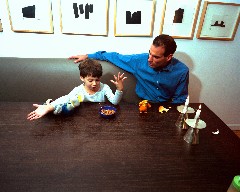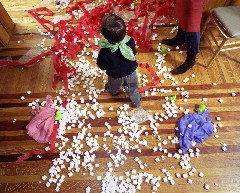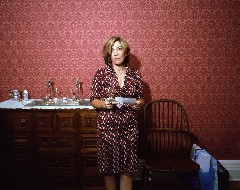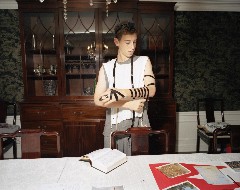
Eddie and Ben, by Andrea Stern
Andrea Stern‘s exhibit of photographs at the Philadelphia Museum of Jewish Art (in Rodeph Shalom on Broad Street), turns out to be a sort of antithesis to the Nan Goldin photos at the Morris Gallery at PAFA (see post).
Stern, in “Inheritance,” is showing 19 images, all family photos, and all way too large to be considered snapshots, although most have a snapshot quality, a quick, capture-the-moment sort of affect.
But there’s no snapshot zaniness here, no posing for the camera as an outside eye, no putting the best face on things that people in snapshots tend to do, with big smiles, posed comaraderie and forced ebullience.

The Ten Plagues, with suggestions of a birthday celebration, presents and too much of a good thing
The photographs are of Stern’s family, and they are taken in New York City, Palm Beach, Los Angeles, and on a Disney Cruise. They show people who are bound to eachother and their shared pasts. The photos have the weight of ancestry and traditions and rituals and possessions. They also have the weight of a life lived in plenty.
Their force is centripetal, and claustrophobic at times. It offers closeness and belonging and love–and airlessness.
Goldin’s world is the very opposite, the force centrifugal, the boundaries not only crossed but smashed through to some escape from all the rules. Goldin’s world is bohemian, a circle of peers who have found eachother and the endless party as they drifted away from the past that suffocated them. Ironically, it’s the intense connection to others, to love and to family that Goldin is seeking.

Cynthia
Stern’s “Cynthia,” in her red-patterned dress, standing in front of a sideboard topped with ritual silver candle sticks and havdalah set, a red-patterned wallpaper behind, seems less the subject than the patterns and the possessions. With her expensive hair streaks and conservative cut, it is the Jewish version of a Main Line matron, woven into the fabric of her life in such a way that it’s no longer her life but the life she was given.
The large scale that Stern chooses for her images puts these photos in the same class as the possessions that Stern is photographing along with the family. There’s a sense here of a European past, a desire to use the possessions–ritual and secular–for ballast and roots.

Marlon, the name alone a sign of assimilation, the leather tfillin straps a sign of Jewish prayer tradition and the ties that bind
The family serves as a bunker, a safe haven away from the American mainstream at the same time the family is wholly of the American mainstream. The exhibit in that richly appointed Jewish house of worship, Rodeph Shalom, raises issues about assimilation and holding on to the past, a past that helped Jews and Jewishness survive in alien lands.
I’m not sure that Stern meant to show her family as both protection and prison. Her artists statement says nothing of the sort.
I’m not sure if I hadn’t seen the Goldin exhibit, that Stern’s photos would have been as meaningful to me. But I had, and they were.
In a way, I am too close to the culture of these pictures, so I had to overcome my personal issues to spend the time with them that they merited.
Some of the photographs are wonderful, telegraphing a complete world, a complete culture, in just a few artifacts and a figure. I once again want to put in a good word for curator Matt Singer, who continues to make this offbeat space worth a visit for provocative contemporary art.









